Understanding Open Incision vs. Closed Suction: Techniques for Surgical Removal of Illegal Silicone Butt Shots
By: Dr. J. Timothy Katzen · 8/20/2024 · Read time: 8 minutes
Introduction to Illegal Silicone Butt Shots
Illegal silicone butt shots, often referred to as “black market” procedures, involve the non-FDA-approved injection of silicone or other foreign substances into the buttocks. Usually, the illegal silicone is not medical grade. This practice has gained notoriety due to its association with severe health complications and even fatalities. It is crucial to understand the nature of these procedures and the risks they entail to appreciate the importance of surgical removal techniques.
The Appeal of Illegal Silicone Butt Shots
1. Many individuals are drawn to illegal silicone injections due to their significantly lower cost compared to legitimate surgical procedures.
2.The allure of a quick and ostensibly simple enhancement can be irresistible, especially given the growing emphasis on body augmentation in popular culture.
3.Often, individuals are unaware of the severe and long-term risks associated with these illegal procedures.
Ingredients and Administration
1. Unregulated silicone, often industrial-grade, is commonly used in these injections, which is not intended for human use.
2.In some cases, the injected material can include a mix of oils, saline, or even other secret substances, thus increasing the risk of adverse reactions. 3. Procedures are typically performed in non-sterile environ
3.Procedures are typically performed in non-sterile environments (hotel rooms and private homes), utilizing unsterilized instruments, further increasing the risk of infection.
Immediate and Long-term Risks
1. Infections are common due to unsterile conditions and non-medical grade substances.
2.Injected silicone can migrate to other parts of the body, causing damage to tissues and organs.
3.The body may react to foreign substances by forming granulomas or hard nodules, which are painful and difficult to treat.
4.There is a risk of silicone embolism if the substance enters the bloodstream, which can be fatal.
5.Persistent pain and chronic inflammatory reactions are frequent, necessitating long-term medical treatment.
Ingredients and Administration
1. Such procedures are illegal in many jurisdictions, and practitioners often lack medical licensing. Most injectors have no medical training and are not licensed to inject anything.
2. Ethical implications are profound, as the individuals performing these procedures are putting lives at risk for profit.
Understanding the appeal, administration, risks, and legal aspects of illegal silicone butt shots underscores the critical need for effective surgical removal techniques such as open incision and closed suction methods. Exploring these methods in greater detail illustrates the complexity and necessity of specialized medical interventions to decrease the damage caused by these dangerous procedures.
Risks and Complications of Illegal Silicone Injections
Illegal silicone injections pose significant health risks and complications. These risks are primarily due to non-medical-grade materials and unqualified individuals administering these injections.
Health Risks
1. Unsterile procedures and environments can lead to severe infections.
2.The body may react negatively, causing swelling, redness, and pain.
3. Non-medical-grade silicone can cause irreversible damage to muscle and skin tissue.
Long-term Complications
1. Silicone can move from the injection site to other parts of the body.
2.These are lumps that form as a chronic inflammatory response.
3.Tissue death due to compromised blood supply. Skin, fat, and muscle can die.
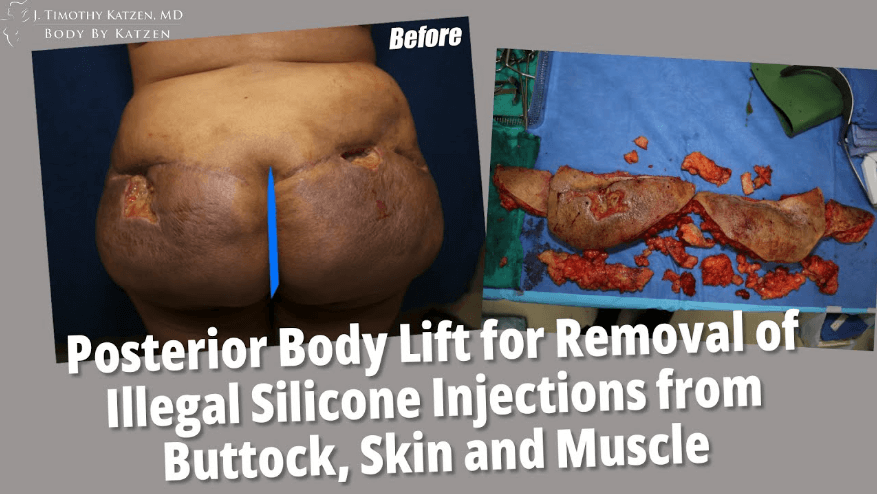
Systemic Complications
1. Silicone entering the bloodstream can block pulmonary arteries.
2.Autoimmune reactions resulting in joint pain, brain fog, and fatigue.
3.Toxicity, hypercalcemia, and systemic inflammation can impair kidney function, leading to kidney stones, kidney failure, and the need for dialysis and kidney transplant.
Cosmetic Consequences
1.Irregular shapes and lumpiness may occur, affecting appearance permanently. The disfigurement can occur at the injection site and in places where the product migrates.
2.Uneven distribution and creation of scar tissue can cause disproportionate and asymmetric buttock shape.
3.Hyperpigmentation, scarring, ulceration, and skin death could develop.
Psychological Impact
1.Emotional Trauma:Physical deformities and health scares can lead to anxiety and depression.
2.Social Stigma: Visible complications may result in social isolation and stigmatization.
3.>Body Dysmorphia: Focused concern on physical appearance can exacerbate existing conditions
Unregulated Environments
1.Unlicensed practitioners are not held to medical standards.
2. Post-procedural care and monitoring are often neglected.
3.Vulnerable individuals are often charged exorbitant fees.
Legal Ramifications
1. Engaging in illegal injections is against the law and can lead to prosecution and jail time.
2.Victims have limited legal options for recourse against unlicensed practitioners.
Overview of Surgical Removal Techniques
Surgical removal of illegal silicone butt injections encompasses various techniques, each with specific indications, advantages, and risks. The primary methods include open incision surgery and closed suction techniques.
Open Incision Surgery
Open incision surgery involves making incisions to directly access and remove silicone material and surrounding scar tissue. This technique is often employed when there is a significant volume of silicone or when the material has migrated to surrounding tissues.
Key aspects include:
1. Plastic surgeons can directly see and more precisely remove foreign matter.
2.Suitable for patients with extensive silicone injections. Compared to the closed technique, the open technique can usually remove more silicone and scar tissue.
3.Allows for meticulous cleaning and debridement of tissues.
4. Allows for skin removal.
5. Allows for contaminated gluteus maximus muscle removal.
6. After the removal of diseased skin, fat, soft tissue, and possible muscle, the buttock can be lifted.
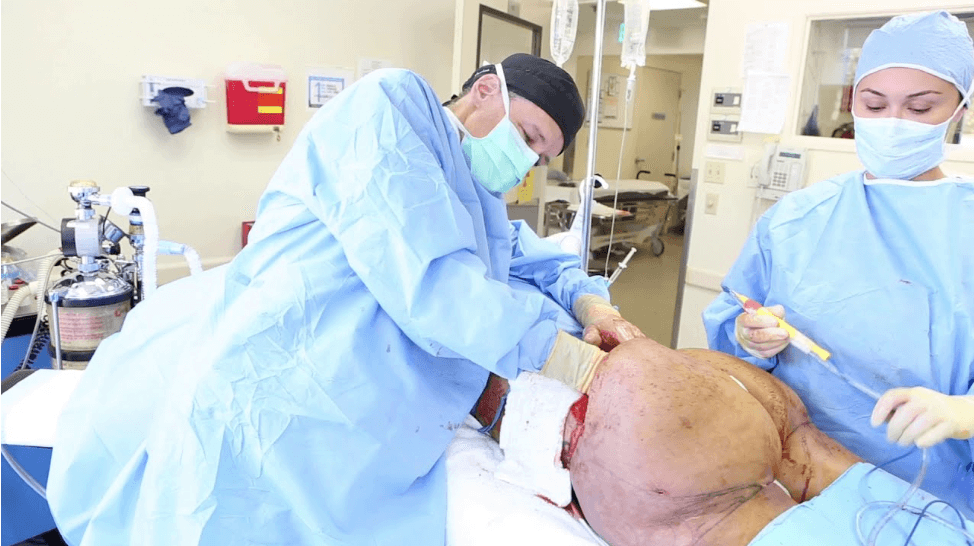
Dr. Katzen performs open silicone injections removal.
Risks and Considerations:
1. Larger incisions can lead to more noticeable scarring.
2.Increased risk of post-surgical infections due to open wounds.
3. Longer recovery periods compared to less invasive methods.
4.If a significant amount of tissue is removed, patients may require buttock reconstruction either with fat transfer, buttock implants, or Sculptra injections.
Closed Suction Techniques
Closed suction techniques, often called suction for silicone removal, involve small incisions and using suction devices, like liposuction cannulas. This method is less invasive and typically used for smaller amounts of silicone or localized deposits.
Key aspects include:
1. Small incisions result in reduced scarring and quicker recovery.
2.Efficient for targeted areas of silicone accumulation.
3.Lower infection rates due to smaller surgical wounds.
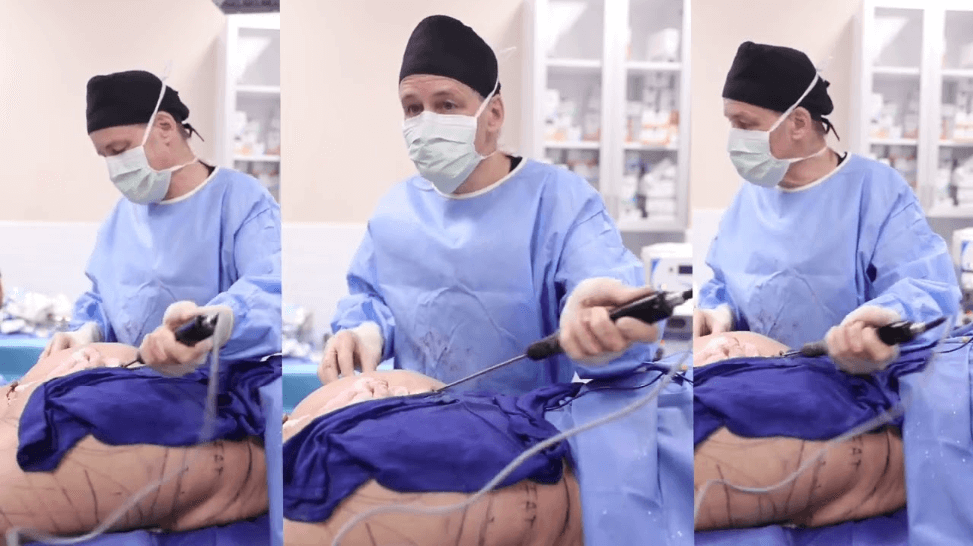
Dr. Katzen used the closed technique to remove silicone injections.
Risks and Considerations:
1. Difficulty in removing all silicone, particularly if it has spread.
2.Potential for uneven skin surfaces post-procedure.
3.In some cases, repeated procedures may be necessary to achieve desired results.
4.If a significant amount of tissue is removed, patients may require buttock reconstruction either with fat transfer, buttock implants, or Sculptra injections..
Combined Techniques
Combining both open and closed methods can provide a balanced approach, tailoring the procedure to individual patient needs.
Key aspects include:
1. Allows plastic surgeons to adapt techniques based on the extent and location of silicone deposits.
2.Combining methods can enhance silicone removal efficacy and aesthetic outcomes.
3.Addresses both superficial and deep silicone deposits effectively.
Risks and Considerations:
1.Increased complexity compared to single-method approaches.
2.Potential for longer recovery due to the combination of technique.
In summary, the choice between open incision, closed suction, or a combination of both hinges on factors such as the quantity and distribution of silicone, skin condition, presence of product in muscle, patient health, and desired cosmetic outcomes. Each technique requires careful consideration by the plastic surgery team to ensure safety and effectiveness.
The Principles of Open Incision Technique
The open incision technique for surgical removal of illegal silicone injections involves several key principles designed to minimize complications and ensure effective removal:
1.Comprehensive evaluation of the patient’s medical history and current health status. Detailed imaging studies, such as MRI, to map the extent of silicone spread. Preoperative marking of incision sites using anatomical landmarks to guide the surgical process.
2. Selection of incision sites based on the distribution and volume of silicone, aiming to access the affected areas with minimal tissue disruption. Design of incisions to follow natural skin folds or less conspicuous areas to reduce visible scarring post-surgery.
3.Administration of appropriate anesthesia, typically general anesthesia, to ensure patient comfort and safety during the procedure. Monitoring of vital signs throughout the surgery by an anesthesiologist.
4.Creation of a precise incision in the marked areas, with careful attention to the depth and direction to minimize damage to surrounding tissues. Gentle dissection through subcutaneous tissues to expose the silicone deposits, using specialized instruments to enhance visibility and control.
5. Identification and meticulous extraction of silicone deposits, with efforts to remove as much foreign material and scar tissue as possible. Flushing of the surgical site with saline solution to remove residual silicone particles and minimize local inflammation.
6.Achieving hemostasis, via cauterization or ligation, to control bleeding and promote optimal healing. Debridement of necrotic tissue and closure of the surgical site in layers, using absorbable sutures for deep tissues and non-absorbable sutures for the skin.
7.Application of sterile dressings and compression garments to support the surgical site and reduce swelling. Prescription of antibiotics and analgesics to lessen the risk of infection and manage pain. Instructions for follow-up visits to monitor healing and assess for complications, such as infection or silicone recurrence.
8.Education of the patient on postoperative care, including wound care, activity restrictions, positioning, and signs of complications to watch for. Provision of psychological support and counseling to help the patient cope with the emotional impact of the surgery and the underlying issues related to illegal silicone injections.
This meticulous approach ensures not only the effective removal of illegal silicone but also supports patient safety and optimal recovery outcomes.
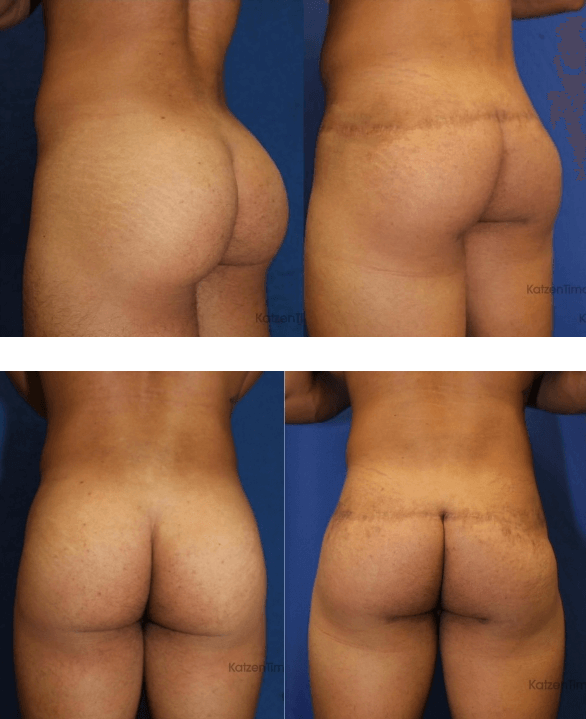
26-year-old male, 5'6" and 175 lbs, sought Dr. Katzen for silicone injection removal from his buttocks. An MRI revealed silicone in both fat and muscle layers, injected in November 2017. Four years later, he experienced pain, skin changes, and brain fog. Dr. Katzen performed a 3-hour posterior buttock lift under general anesthesia, removing 2 lbs of contaminated tissue. The patient could return to limited activity after four weeks and is expected to fully recover in 6-8 weeks.
Benefits and Drawbacks of Open Incision
Open incision technique involves a visible surgical cut to gain direct access to the affected area, such as illegal silicone buttock injections.
Benefits:
1.Plastic surgeons have a clear view of the affected tissues and can directly assess and address the extent of silicone spread.
2. Allows greater precision in removal, which is critical for minimizing damage to surrounding healthy tissues.
3.Increases the ability to thoroughly irrigate and clean the area, reducing the risk of infection.
4.Facilitates the retrieval of silicone deposits. Useful for addressing complications like infections or granulomas promptly.
5. Enhances the opportunity for reconstructive techniques during the same procedure.
Drawbacks:
1.Results in more noticeable scarring compared to minimally invasive methods. Potentially requires cosmetic follow-up procedures to improve appearance.
2. Longer recovery period due to the extent of the incision. Increased post-operative discomfort.
3.While cleaning is thorough, the risk remains due to the larger wound area exposed.
4.Greater potential for blood loss during surgery.
5. Requires more intensive post-operative care and monitoring.
6. Generally associated with higher costs due to more extensive surgical procedures and longer recovery times.
Ensuring an informed decision about the choice of procedure and understanding its implications are crucial.
Understanding Closed Suction Technique
The closed suction technique is employed for removing illegal silicone injections, wherein plastic surgeons utilize a specialized closed system that minimizes the risk of infection and contamination. This technique involves inserting a cannula into the incision, through which the silicone material and surrounding scar are aspirated.
Advantages of Closed Suction Technique
1.The closed system reduces the exposure of internal tissues to external contaminants, thereby theoretically lowering the risk of postoperative infections.
2. The suction mechanism allows precise control over the removal of fluids and silicone, ensuring that minimal damage occurs to the surrounding tissues.
3.The use of suction helps to maintain a clear surgical field, reducing the occurrence of bleeding and enabling the plastic surgeon to work more efficiently.
4.Patients often experience faster recovery times due to the minimized trauma to the surrounding tissue and the reduction of complications often associated with open incisions.
Procedure Steps
1.Preoperative Preparation:Before surgery, the patient is evaluated for any underlying conditions that might impede healing. A detailed plan is formulated, including the targeted areas for silicone removal.
2.Anesthesia Administration: Usually, general anesthesia is administered.
3.Incision and Cannula Insertion: A small incision is made near the site of silicone injection. A cannula attached to a closed suction device is gently inserted through this incision.
4.Aspiration: The silicone material and any inflammatory fluids are aspirated through the cannula using a controlled suction mechanism. The plastic surgeon continuously monitors the process to ensure complete removal while minimizing tissue damage.
5. Closure Once the aspiration is complete, the incision is closed with sutures. Usually, a drain is placed. A sterile dressing is applied to protect the site and promote healing.
Postoperative Care
1.Patients are monitored in a postoperative care unit for any immediate complications such as bleeding or infection.
2.Appropriate pain management strategies, including medications and a pain pump, are prescribed to alleviate discomfort and facilitate healing.
3.Regular follow-up appointments are essential to monitor the patient’s recovery and to address any concerns promptly.
Understanding the closed suction technique is crucial for medical professionals dealing with the complex and often hazardous task of removing illegal silicone buttock injections. This method offers numerous advantages in terms of safety, efficiency, and patient outcomes, thereby making it a preferred choice in many scenarios.
Advantages and Limitations of Closed Suction
Closed suction has several distinct advantages for use in surgical removal of illegal silicone butt shots. Notably, this technique tends to minimize tissue damage and reduce the risk of infection. Here are some of the key advantages:
Advantages:
1. Closed suction systems use controlled vacuum pressure to remove silicone material, which lessens the risk of inadvertent tissue damage compared to manual excision methods.
2. By maintaining a closed environment, these systems limit exposure to airborne pathogens, thereby reducing the chances of postoperative infections.
3. Plastic surgeons can better regulate suction strength and direction, allowing for more precise removal of silicone deposits.
4. With fewer and smaller incisions required, patients often experience reduced scarring and quicker healing times.
5. The controlled nature of closed suction minimizes bleeding during the procedure, thereby reducing the chances of complications arising from blood loss.
6. Typically, the less invasive nature of closed suction results in reduced postoperative pain and faster recovery times for patients.
Despite these advantages, there are also notable limitations associated with closed suction techniques.
Limitations:
1. Closed suction might not fully eradicate all silicone deposits, especially those that are deeply embedded or spread out over a large area. Also, the closed technique cannot remove silicone from the surrounding gluteus maximus muscle.
2. Successful execution relies heavily on specialized equipment and proficient use, which may not always be available or affordable.
3.Mastery of closed suction techniques often requires additional training and experience, which can be a barrier for some plastic surgeons.
4.The suction lines can become clogged with debris, necessitating frequent monitoring and maintenance during the procedure.
5. The enclosed nature of the closed suction system can restrict the plastic surgeon’s visualization of the operative field, sometimes making it challenging to ensure all unwanted materials are removed.
6. The specialized equipment associated with closed suction systems can be expensive, potentially increasing the overall cost of the procedure.
In summary, while closed suction techniques offer a range of benefits, including reduced tissue damage and infection risk, they also come with limitations such as potential incomplete removal and high costs.
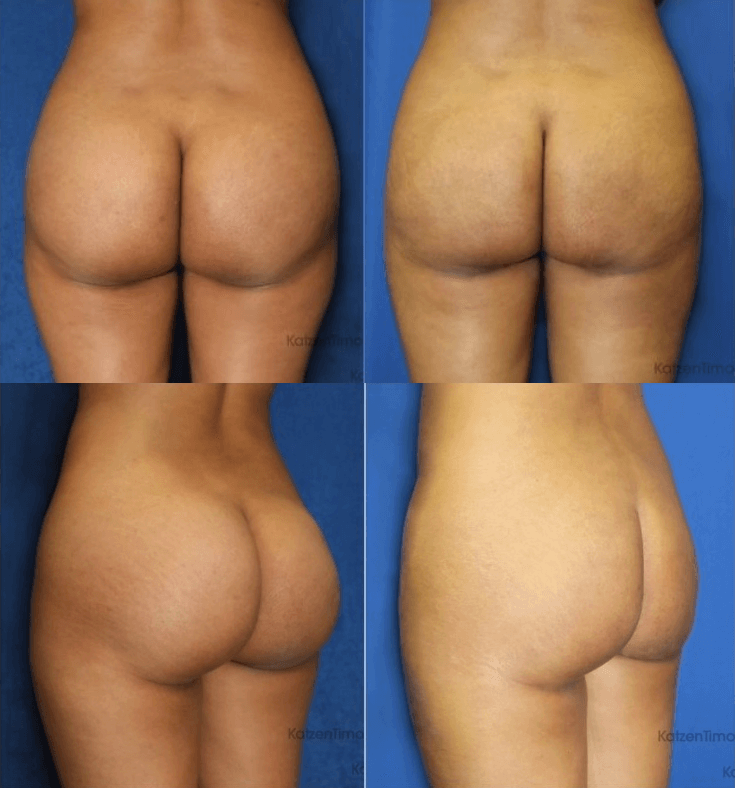
23-year-old patient had raw silicone injected into her buttocks, causing pain. She traveled from Houston to Beverly Hills for treatment by Dr. J. Timothy Katzen. After an ultrasound- guided, VASER- assisted removal, she now experiences significant relief. This highlights the importance of choosing qualified professionals for safe cosmetic procedures.
Comparative Analysis: Open Incision vs. Closed Suction
Open Incision Technique
1. Involves a surgical cut to access and remove silicone. Typically, the incision is sizeable to ensure complete removal. Used for substantial silicone deposits.
2. Allows direct visualization. Facilitates complete removal. Can address extensive contamination.
3. Higher risk of infection. Increased tissue trauma. Extended recovery time. More prominent scarring.
Closed Suction Technique
1. Utilizes small cannulas with suction. Involves minimal incision points. Often assisted by imaging techniques for precision.
2. Less invasive. Reduced scarring. Quicker recovery. Lower infection risk.
3.Difficult to ensure all silicone is removed. Relies heavily on the plastic surgeon’s skill. Potential for incomplete removal.
Comparison of Outcomes
1. Open incision ensures thorough removal; closed suction may leave residual silicone. Open incision is preferred for severe cases; closed suction is better for localized issues.
2. Closed suction has a lower risk of post-operative complications. Open incision involves higher risk but offers more control.
3. Closed suction offers faster recovery with less downtime. Open incision requires extended rehabilitation.
4. Open incision leads to more noticeable scars. Closed suction limits scarring, beneficial for cosmetic considerations.
Procedure Suitability
1. Patient Condition: Severe silicone migration and infection may necessitate an open incision. Localized silicone deposits are suitable for closed suction treatment.
2. Plastic Surgeon's Expertise: Open incision requires precise surgical skills and strong anatomical knowledge. Closed suction demands experience with imaging tools and technique proficiency.
3. Health Considerations: Patients with compromised immunity might benefit more from less invasive closed suction procedures.
Those needing comprehensive silicone removal lean towards open incision despite the inherent risks.
Patient Evaluation and Preoperative Considerations
The initial patient consultation involves a thorough medical history review and physical examination. It is crucial to understand the volume, type, and sites of illegal silicone injection. This information can be acquired through patient interviews and, if possible, documentation or third-party accounts.
A detailed discussion regarding the patient’s symptoms, such as pain, hardening of tissues, or signs of infection, is imperative. Symptoms may include:
1. Often associated with inflammation or infection.
2. Indicating possible granuloma or fibrosis formation.
3. Signs of inflammatory reactions.
4. Signs of inflammatory reactions.
Imaging studies should be employed to assess the extent and location of silicone migration.
Recommended modalities include:
1. Preferred for its clear delineation of soft tissue changes and silicone distribution.
2. Useful for identifying fluid collections and granulomas.
3. Limited in soft tissue resolution but helpful for planning extensive removals.
Laboratory assessments should include:
1. To check for signs of systemic infection.
2. To gauge the level of systemic inflammation.
3. Necessary to evaluate any impact on kidney function.
Preoperative counseling must involve discussing the potential outcomes, including the risks of infection, bleeding, and incomplete removal. Due to the inherent risks of the procedure, informed consent is vital. Document the following in the consent form: Risks of surgery, including anesthesia complications. Possibility of incomplete silicone removal. Potential need for additional procedures. Postoperative expectations, including pain management and recovery time.
Preoperative preparations should also include:
1. Ensuring conditions like diabetes or hypertension are well-controlled.
2. To minimize postoperative infections.
3. To confirm adequate healing capability.
4. To minimize the chance of blood clots, blood thinners and compression devices are given.
5. Patients with psychological distress due to the physical and emotional impacts of silicone injections should be referred to a mental health professional for support and counseling.
Postoperative Care and Recovery Process
Postoperative care is crucial for patients who undergo surgical removal of illegal silicone butt shots. Effective management is key to ensuring optimal recovery and minimizing complications.
Immediate Postoperative Care
1. Vital signs, including blood pressure, heart rate, and oxygen saturation, are continuously monitored. The surgical site is inspected for signs of excessive bleeding or infection.
2. Pain relievers, such as acetaminophen or prescribed opioids, are administered based on the patient’s pain levels. Non-pharmacological methods, like compression and massage, may supplement pain control.
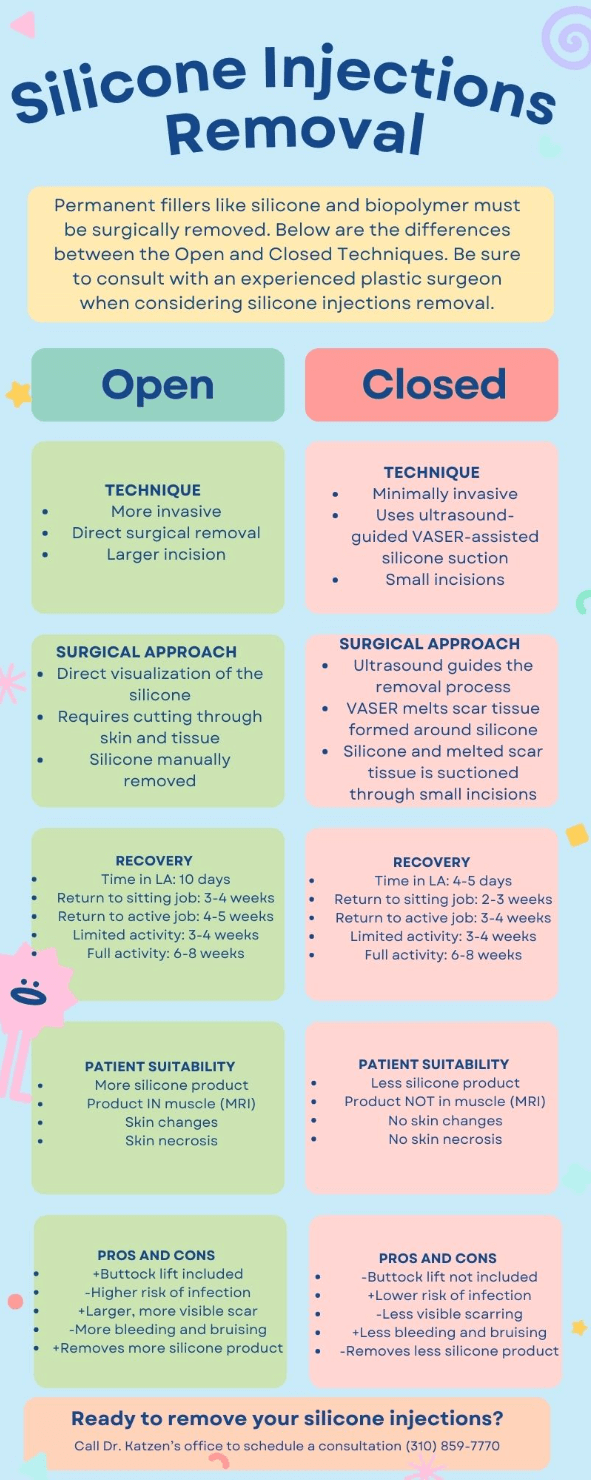
Permanent fillers like silicone and biopolymer must be surgically removed.
3. Dressings are maintained to keep the incision clean and dry. Patients with closed suction techniques should ensure the drain remains functional and unclogged.
Medium-Term Recovery Process
1. Follow-Up Appointments: Regular follow-ups are scheduled to assess healing progress and detect any complications early. Removal of sutures or drains is typically performed during these visits.
2. Medication Administration: Antibiotics may be prescribed to minimize infections. Anti- inflammatory medications could be recommended to reduce swelling and promote healing.
3. Long-Term Maintenance:
- Activity Restrictions: Patients are advised to avoid strenuous activities and heavy lifting for several weeks after surgery. Gentle exercises, such as walking, can be gradually introduced to promote circulation and reduce the risk of blood clots.
- Lifestyle Modifications: Maintaining a healthy diet rich in proteins and vitamins aids in tissue repair. Smoking cessation is strongly recommended, as smoking can impair wound healing and increase infection risk.
Psychological Support
Psychological support is beneficial due to the emotional impact of undergoing such a procedure. Counseling or support groups may assist patients in coping with body image changes and recovery challenges.
Potential Complications and Warning Signs
1. Redness, increased pain, and fever are indicators that require prompt medical attention.
2. Swelling or fluid accumulation near the surgical site necessitates evaluation.
3. Adverse scarring should be monitored, with treatments available if excessive keloid formation occurs.
Patient Education
1. Clear instructions on how to care for the wound at home are provided. Patients are educated on the signs of infection and when to seek medical help.
2. Patients learn how to properly care for empty drainage systems if used in closed or open techniques.
By adhering to these postoperative care protocols, patients can achieve a smoother recovery and better surgical outcomes.
Case Studies and Success Stories
Case Study 1: Immediate Intervention and Stabilization
A 34-year-old female presented with chronic pain and recurring infections after receiving illegal silicone injections. Upon examination, she exhibited signs of silicone migration. The surgical team opted for an open incision technique to ensure complete removal. Pre-operative planning included detailed MRI imaging to localize silicone deposits. During the procedure, large volumes of free-floating silicone were excised, followed by tissue debridement. Post-surgery, the patient experienced significant relief from pain and a marked reduction in infection frequency. Follow- up showed no recurrence of symptoms, highlighting the efficacy of the open incision method in complex cases.
Success Story 2: Minimally Invasive Efficiency
A 28-year-old female suffering from localized inflammation post-silicone injections underwent a closed suction procedure. The surgical plan involved ultrasound-guided VASER-assisted aspiration, minimizing incision size, and reducing tissue trauma. The operation successfully removed over 95% of silicone with minimal scarring. The patient reported minimal pain post- procedure and resumed normal activities within two weeks. Her six-month follow-up showcased no recurrence, demonstrating the closed suction technique’s effectiveness in targeted silicone removal.
Case Study 3: Comprehensive Management of Complications
A 30-year-old male with severe complications, including tissue necrosis and abscess formation, post-illegal silicone butt shots underwent a combined approach. The initial intervention involved an open incision for extensive debridement and silicone removal, followed by a closed suction phase to address residual silicone pockets. The dual approach resulted in optimal removal, reduced infection risks, and better overall outcomes. The patient’s recovery was monitored through regular imaging and blood tests, confirming complete recovery with no lasting complications.
Success Story 4: Addressing Silicone Migration
A 36-year-old patient presented with silicone migration issues extending into the lumbar region. Given the complexity, a multi- disciplinary team decided on an open incision technique. The intricate procedure involved careful dissection around sensitive areas to excise migrated silicone safely. Post-operatively, the patient showed significant symptom improvement and regained full mobility. Regular follow-ups confirmed the procedure’s success, with no complications or further silicone spread.
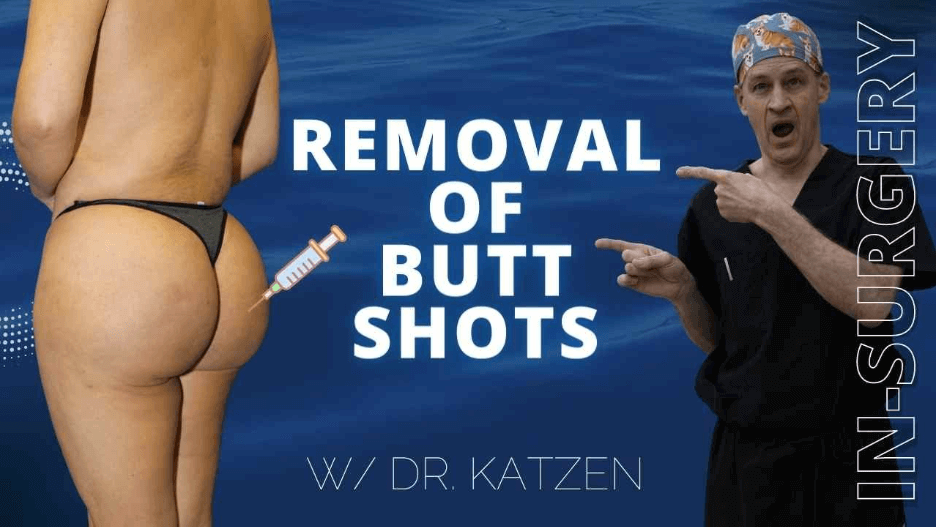
Transformative Journey: Silicone Removal and Buttock Implants Restore Confidence after Years of Pain and Discomfort
This 33-year-old Asian female had raw silicone injections in her buttocks in 2009, leading to issues like redness and discomfort. In November 2020, she had a posterior body lift for silicone removal with Dr. J. Timothy Katzen in Beverly Hills. The surgery was successful, improving both appearance and comfort. In July 2022, she returned for bilateral buttock implants, with outstanding results. She now feels more confident and comfortable in her body. We are honored to have been part of her journey.
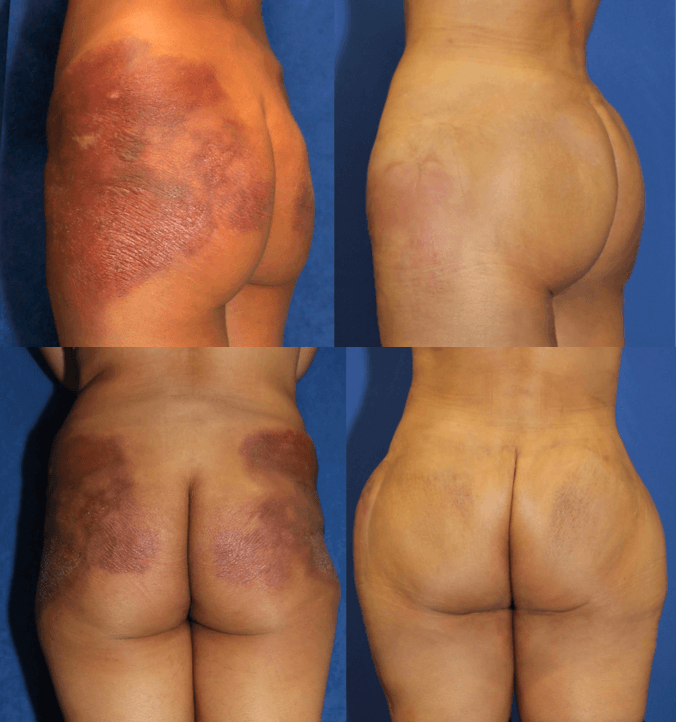
Conclusion: Choosing the Right Method for Silicone Buttock Injection Removal
The decision between open incision and closed suction techniques depends on several key factors unique to each patient and their medical history. It is imperative for plastic surgeons to carefully weigh these factors to ensure optimal outcomes for surgical removal of illegal silicone butt shots.
Key Considerations
1. Localized vs. Diffuse: Patients with localized silicone may benefit more from an open incision, offering direct access and visual control. In more diffuse cases, closed suction might be preferable to minimize tissue disruption.
2. General Health: Factors such as preexisting conditions, immune system health, and potential for infection should guide the choice of technique. Healing Capacity: Given that open incision procedures are more invasive, patients with compromised healing capabilities may fare better with closed suction.
3. Cosmetic Results: Open incision may provide more precise removal, potentially resulting in better cosmetic outcomes, but also carries a higher risk of scarring compared to closed suction. Recovery Time: Closed suction often offers quicker recovery times and less post- operative discomfort, which can be a significant consideration for patient quality of life.
4. Specialization: The chosen technique should align with the plastic surgeon’s expertise and familiarity. Specialized experience in either method can significantly influence success rates and complication management.
Risk Management
Professionals must also evaluate the procedural risks associated with each method:
1. Closed suction procedures generally pose a lower risk of infection due to the minimal nature of incisions.
2. Open incision techniques might have higher immediate post-operative complication rates but allow for more thorough removal in complex cases.
3. Closed suction techniques may sometimes require subsequent revisions, particularly in cases where initial removal was incomplete.
Patient Consultation
Professionals must also evaluate the procedural risks associated with each method:
1. Detailed discussions with the patient about the risks, benefits, and realistic outcomes of each technique are essential. Providing comprehensive information will help patients make informed decisions.
2. Customizing the surgical plan to each patient’s unique circumstance promotes better overall results and patient satisfaction.
By considering these factors holistically, medical professionals can make well-informed decisions regarding the most appropriate method for the surgical removal of illegal silicone butt shots, ultimately aiming to enhance both health outcomes and patient satisfaction.
If your silicone buttock shots bother you, Call TODAY to schedule a consultation. Physical or virtual consultations can be arranged. Virtual consultation options include FaceTime, Zoom, Skype, and WhatsApp. Call TODAY at (310) 859 - 7770 to schedule your consultation to regain your health and natural beauty.